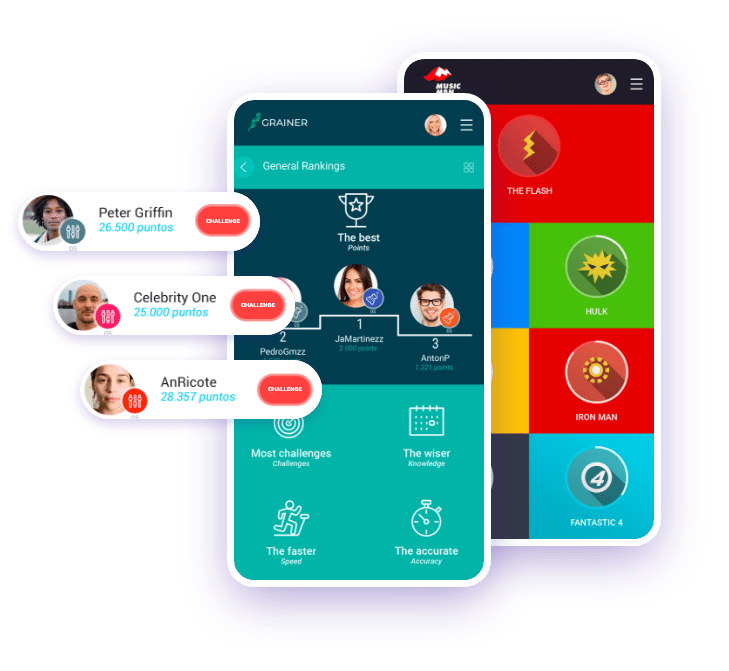Table of contents
ToggleWhen aiming to enhance your team’s skills, your goal is to provide your collaborators with the necessary tools to learn effectively and efficiently. To achieve this, it is essential to understand and implement learning strategies that allow for the most efficient use of time, both yours and that of your team members.
In this article, we’ll explore what learning strategies are and why they are so important in the modern business world. We’ll also discover practical ways to apply them so you can improve training in your company, and find out how they can make a difference to skills development in your team.
What are learning strategies?
Learning strategies are planned and structured approaches to learning that seek to improve the acquisition of knowledge and skills. These methods seek to enhance an individual’s ability to study, helping them to better understand, retain, remember and apply any content studied. Crucially, they do this by taking into account the fact that there are many different types of students, with many different learning styles.
Learning strategies go far beyond traditional processes of memorizing and repeating. These techniques ask students for active participation and interaction with study materials to achieve objectives such as improving memory, enhancing skills, and developing critical thinking.
The key features of learning strategies
Effective learning strategies have a set of well-defined characteristics that help students to achieve their goals and maximize the impact of their studies. Some of the most important are:
- Intentionality: Learning strategies are designed with a clear purpose, channeling our efforts towards specific goals. For example, in corporate training the intention of our strategies must be aligned with wider organizational objectives.
- Adaptability: Effective strategies are also flexible, capable of adjusting and evolving according to individual needs. A good learning strategy ensures that a company can help its employees to adapt quickly to changes in the work environment.
- Active participation: We learn best when we are actively involved in the process. Successful learning strategies encourage active participation, transforming learning from a passive process into an experience that completely engages the student.
- Flexibility: As with adaptability, learning strategies must take into account the fact that each student has their own style and learning pace. Therefore, they must be adaptable, allowing each student to find their own path to success.
- Metacognition: Beyond simply helping us to absorb information, good strategies should prompt us to reflect on how we learn, providing the tools to understand and control our own cognitive process.
- Transferability: Strategies should equip us with the ability to take knowledge beyond theory, applying what we have learned to diverse real-life situations
- Motivation and self-regulation: Self-direction in learning is vital, as is a high level of motivation. Effective learning strategies not only teach, but also motivate students and encourage self-autonomy for consistent learning.
- Interdisciplinary value: Finally, the usefulness of learning strategies is not limited to just one specific area of life. On the contrary, these strategies can be applied in many different contexts, including corporate training, to ensure the continued relevance of learning in any environment.
What are the objectives of learning strategies?
Learning strategies are powerful tools that help us to improve the learning experience, and achieve specific objectives:
Improve comprehension and retention of material
Crucially, they help students to gain a deeper level of understanding by actively engaging them with the material. Simultaneously, their knowledge retention is strengthened through techniques such as spaced repetition, which help learners to remember any information they absorb and apply it in different contexts.
Develop critical and analytical skills
Beyond simply memorizing concepts, learning strategies aim to cultivate key critical and analytical skills. By involving students in activities that encourage them to solve problems, evaluate scenarios and apply knowledge, they promote the development of skills such as problem solving, effective communication and leadership.
Promote autonomy and self-regulation
These strategies seek to empower students to take charge of their own learning process, encouraging self-autonomy and the ability to manage their own development effectively.
Develop metacognitive skills
Learning strategies encourage reflection on the learning process itself, allowing students to determine how they learn best and adjust their personal approach accordingly. This ability will serve them well at many different stages of their lives.
Stimulate motivation and interest
No longer is the student merely a spectator, the helpless victim of traditional and potentially monotonous learning techniques. On the contrary, modern learning strategies seek to maintain their motivation and interest over time, creating an environment of participation that encourages active learning.
Optimize study time
Another objective of these strategies is the optimization of time, which is of course an invaluable resource. Each strategy seeks to maximize study efficiency, ensuring that every moment dedicated to learning can be as valuable and productive as possible.
Classification of learning strategies
Learning strategies are not one single approach, but rather a diverse set of tools designed to adapt to different types of students and their educational needs. These can be classified as follows:
Strategies according to the nature of learning
- Cognitive: Focused on the way students process and assimilate new information. They involve the organization of data, the creation of mental maps and the forming of relationships between concepts.
- Metacognitive: Aimed at self-autonomy in the learning process. These strategies involve planning, monitoring and evaluation.
- Motivational: They seek to stimulate and maintain the student’s intrinsic motivation for learning. They do this through setting goals, making use of rewards, and forming emotional connections depending on the individual’s learning style
Strategies according to learning style
- Visual: Aimed at students who learn best through images and graphics. For example, the use of mind maps, diagrams or videos.
- Auditory: Designed for those who learn best through sound. For example, lectures, debates or oral repetition techniques.
- Kinesthetic: Aimed at individuals who learn best through practical experience and movement. For example, simulations or practical projects.
Strategies according to the approach
- Individual: Strategies designed for autonomous learning, where the student largely works independently. These would include, for example, reading, research and self-assessment.
- Cooperative: Focused on learning through interaction and collaboration with others. Group discussions and collaborative projects are just a few examples.
Strategies according to presentation style
- In-person strategies: Used in physical environments such as classrooms or workshops.
- Online strategies: Targeted for virtual environments that take advantage of technology, such as online courses, webinars and educational platforms.
4 examples of learning strategies to apply in corporate training
In corporate training, it’s possible to utilize various learning strategies that make the learning process more effective and attractive for employees. Some of the most popular strategies include:
Active learning
A learning strategy that promotes the direct participation of employees in the learning process. It encourages employees to actively apply theory through rigorous practical exercises. Discover more about active learning.
Collaborative learning
Encourages interaction between team members, promoting the fluid exchange of ideas and experiences. This strategy seeks to improve understanding through dialogue and collaboration. Discover more about collaborative learning.
Interactive learning
This strategy uses technologies and resources that stimulate active participation. From simulations to interactive platforms, this type of learning catapults the absorption of knowledge to new levels. Explore interactive learning here.
Gamified learning
Introduce game elements into the educational process to motivate and engage employees. With features like challenges, rewards and competitions, gamification transforms training into an exciting experience. Go deeper into gamified learning.
How to implement learning strategies in your company
When implementing learning strategies in any company, it’s best to follow a planned approach adapted to the specific needs of your organization. Here are some key steps to ensure a successful implementation:
1. Take into account your organization’s goals
Understanding your company’s objectives will allow you to design training programs that directly contribute to organizational success. Try to connect each learning strategy with the results you hope to achieve for your company.
2. Create a training program based on the most pressing needs of your organization
Conduct a detailed analysis to determine the skills and knowledge needed for business growth. Then, design specific programs to address those needs, ensuring that training is relevant to keep things going in the right direction.
3. Keep in mind the unique characteristics of your target audience
Recognizing that each employee has a unique style and learning rhythm is key. Customize strategies based on these differences, making sure that training is accessible and effective for everyone.
4. Integrate learning into the organizational culture
Fostering a culture of continuous learning is essential for long-term success. All employees, from leaders to work teams, must be committed to learning as an integral element of growth. Along the same lines, try to promote active participation, and the practical application of knowledge on a daily basis.
5. Review, evaluate and adjust
Continuous evaluation is the key to measuring the effectiveness of your learning strategies. Carry out regular evaluations to analyze the impact of training on organizational performance and results. With this information, you can adjust your strategies, taking into account the feedback obtained.
The effective implementation of learning strategies in a company not only enhances employee development, but also drives organizational growth and innovation.
Are you looking for the perfect strategy? At isEazy, you’ll find the best e-learning tools to take your business to a whole new level. We provide high-quality, intuitive and easy-to-use software, offering you a 360º e-learning experience with the perfect tool for every business need. Ready to take the leap? Discover the number one choice for all your training projects.

















